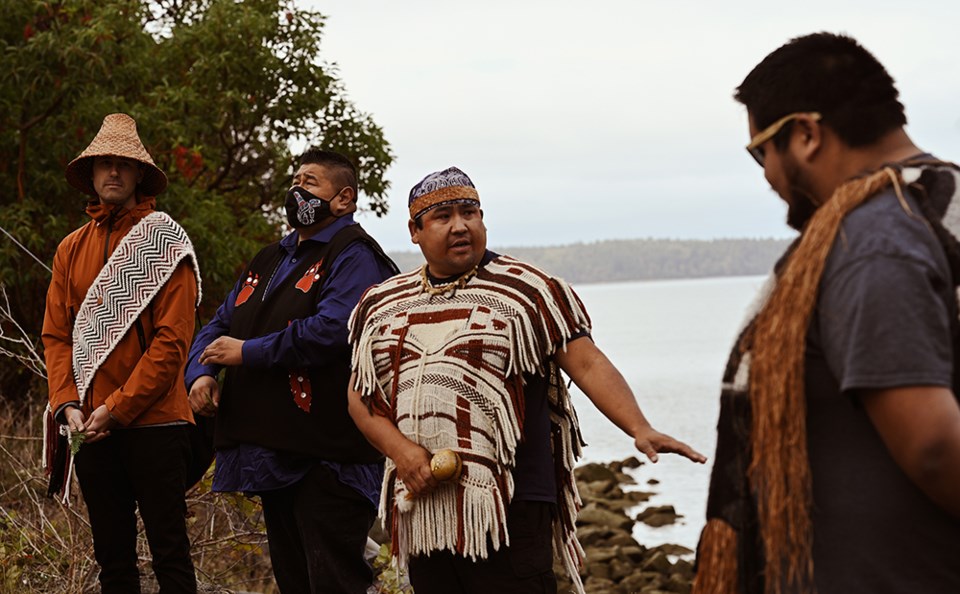A ceremony held at the Townsite mill site on October 1, attended by Tla’amin Nation representatives, mill staff and community leaders, was an important exercise in relationship building.
“The ceremony that took place was very emotional, leading up to the burning ceremony,” said Tla’amin hegus John Hackett. “I did some research. What I found made my heart drop. Tis’kwat [pronounced Tees-kwat], in translation, is big river. Tis’kwat is the original village site of Tla’amin. It is very clear why Tla’amin picked Tis’kwat.”
Hackett said the river holds rich spawning ground for pacific salmon that feeds healthy, diverse wildlife.
“I vision the diversity of wildlife and the habitat provided food and medicines,” said Hackett. “Oral history has taught us that we used to send our young men on a journey to hunt and gather medicines along Tis’kwat. In 1878, Tla’amin lost Tis’kwat as a logging licence for Lot 450 was issued.”
Hackett said at the ceremony, Tla’amin elders and leaders had an opportunity to celebrate the renaming of the Catalyst Powell River mill by having a sacred burning ceremony onsite at Tis’kwat.
“We acknowledge that it’s been over 100 years since Tla’amin has been able to practice such a sacred ceremony,” said Hackett. “Leading up to the ceremony, the elders gathered at the mill entrance. I could feel the excitement in the air; I had goosebumps.
“It was a very positive feeling as all our elders were curious if fish still swim up the mouth of Tis’kwat. Sure enough, it was confirmed there are still fish trying to come home to Tis’kwat to spawn. Our elders got to see them with their own eyes and they felt that we needed to do something to help them, like a fish ladder or open a bypass. The elders were very excited to see the fish, but soon realized the dam around the corner would be as far as they can swim.”
Hackett said he sees reconciliation as a long path and many steps such as this need to be taken to move forward.
“I feel the support and appreciate the local businesses and other entities taking that step and reaching out to our nation wanting our input on how they can change their company name, or how to address cultural sensitivity,” said Hackett. “These are steps down that path of reconciliation. I see reconciliation as an attempt to rebuild from a broken relationship. We will learn from past mistakes and reconcile these mistakes to evolve our relationship and move forward.”
Renaming reflects heritage
Krista Cuddy, general manager of the local mill that is undergoing a renaming process to reflect the Tis’kwat heritage, said the burning ceremony was definitely in the spirit of reconciliation.
“It was a great honour that we were actually able to facilitate access for the Tla’amin Nation and give the ability to honour their ancestors,” said Cuddy. “It was very special.”
Cuddy said the ceremony was organized through discussions and collaboration between Tla’amin and the Paper Excellence company which owns the mill.
“We want to work together with Tla’amin Nation and part of that is the announcement of changing the site name,” said Cuddy. “Through discussion around what are the next meaningful steps, I think this was very symbolic in honouring the past and moving forward.”
Cuddy said the nation was very open to allowing mill representatives to attend and participate in the ceremony. She said the ceremony was held right along the riverbank, where there is a little clearing, and those participating in the ceremony were able to gather at this important site.
“We want to respect the past and we want to move forward and have a brighter future,” said Cuddy. “There are more discussions about what the next steps are. We are very optimistic.”
City of Powell River mayor Dave Formosa said he applauds Paper Excellence and Catalyst Paper for the reconciliation offer of the name change at the location of the mill on Tis’kwat lands.
“I was honoured to be invited to the historic event, where First Nations had not had a celebration or gathering over a fire pit since colonialism, when these lands were taken away from them,” said Formosa. “I was honoured to be there; I was honoured to be asked to speak and I support Paper Excellence and Catalyst Paper in their journey of reconciliation within the traditional territory of the Tla’amin Nation.”
At the city committee of the whole meeting on October 5, councillor George Doubt said he’d had the honour of attending, with other members of council and qathet Regional District, the burning ceremony at the Tis’kwat paper mill site.
“It was a ceremony to honour the ancestors of the Tla’amin people who lived in the region and had a longhouse and a village set up beside the river, down on what is now Tis’kwat mill property,” said Doubt. “It was a solemn ceremony that hasn’t happened for 100 years. It was an honour to be present at that and I thought it was a step forward in the relationship with the community and the Tla’amin Nation.”
City councillor CaroleAnn Leishman said she also felt honoured to be at the ceremonial burning on October 1.
“I was just very grateful for our relationship with Tla’amin,” said Leishman. “We’re finally starting to embrace the learnings and embrace working together on a much more meaningful level. It was very powerful.”
Powell River-Sunshine Coast MLA Nicholas Simons said it was such an honour to attend the ceremony with elders and Tla’amin leadership for this “very moving event.”
“It was moving for many reasons,” added Simons. “It was the first time this ceremony has been performed and conducted in Tis’kwat in more than 100 years. It gives me a lot of hope that there will be good feelings as we walk this new path of reconciliation together. Bringing that name back to the river is a key and important event.
“The resilience of the Tla’amin Nation was clear.”



